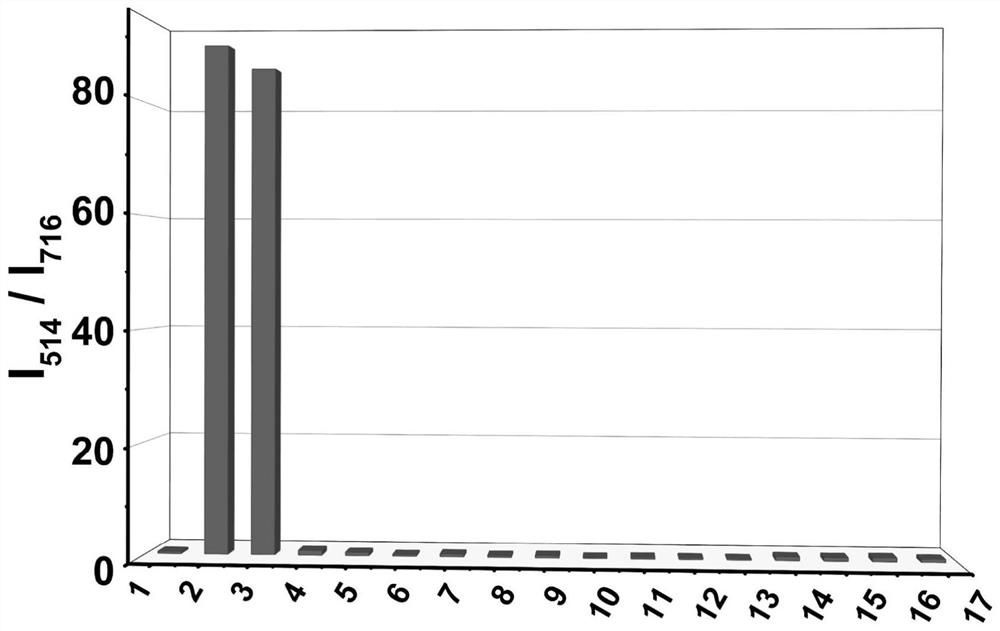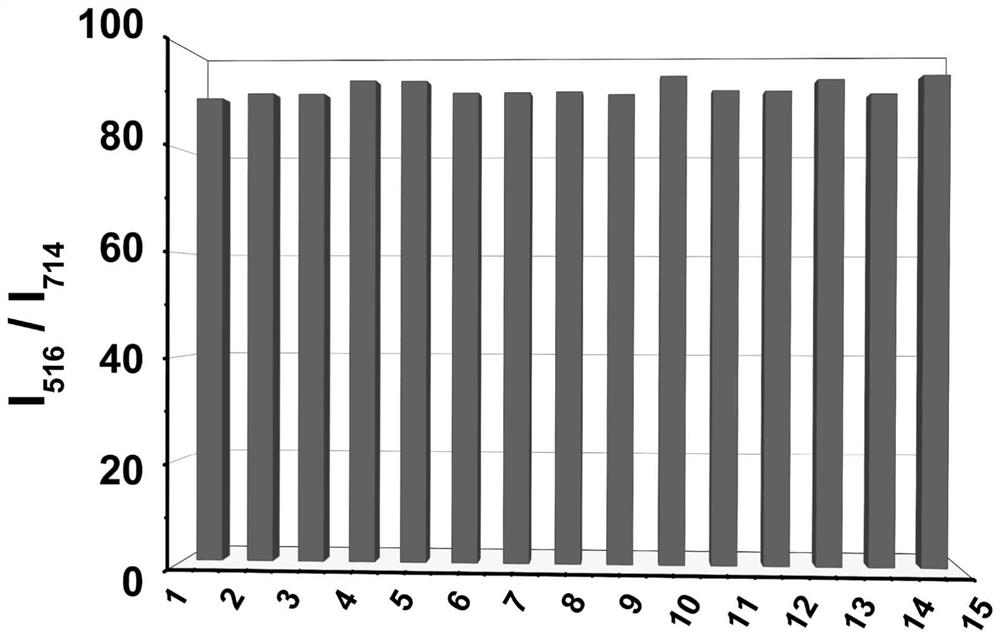Ratio type near-infrared fluorescent probe for detecting sulfur dioxide derivatives and preparation method thereof
A technology of sulfur dioxide and fluorescent probe, applied in the field of fluorescence detection
- Summary
- Abstract
- Description
- Claims
- Application Information
AI Technical Summary
Problems solved by technology
Method used
Image
Examples
Embodiment 1
[0043] Synthesis of fluorescent probes.
[0044] The preparation steps are summarized as:
[0045] Step 1. Dissolve m-diethylaminophenol in concentrated hydrochloric acid and water to prepare a mixed solution, then dissolve sodium nitrite in water, and drop into the above mixed solution in an ice bath. After further stirring, the resulting yellow solid was collected by filtration and washed with saturated sodium acetate solution. Then recrystallize to obtain red needle-like crystals;
[0046] Step 2, adding the intermediate product obtained in step 1 to ethanol. The resulting mixture was added with 85% hydrazine hydrate, and then a palladium carbon catalyst was added to the mixture under a nitrogen atmosphere, and the mixture was stirred under reflux until the red color of the solution disappeared. To avoid oxidative degradation, the obtained compound 2 was used directly in the next step without purification step.
[0047] Step 3, adding ethyl pyruvate to the solution obta...
Embodiment 2
[0057] The fluorescent probe that embodiment 1 obtains is to HSO 3 - Selectivity of fluorescence detection.
[0058] Concentrate 5×10 in DMF -4 M fluorescent probe molecular mother solution, ready to use. Prepare a concentration of 1×10 with deionized water -3 M's HSO 3 - (2), SO 3 2- (3), S 2 o 3 2- (4),HS - (5), HSO 4 - (6), SO 4 2- (7),Na + (8),Mg 2+ (9),F - (10), Cl - (11), NO 2 - (12),ACO - (13), NO 3 - (14), Cys(15), Hcy(16), and GSH(17) solutions, wherein (1) is a blank solution, when various analyte solutions are added to the test solution of 5 μM fluorescent probe molecules, at 421nm As the excitation wavelength, the fluorescence spectrum is measured, and the response of the probe molecule to different analytes is detected. The measurement results are as follows: figure 2 shown.
[0059] from figure 2 The results can be found that only HSO 3 - and SO 3 2- The fluorescence of the fluorescent probe can be significantly enhanced, and the ...
Embodiment 3
[0061] Other common ions or molecules interfere with the detection of hydrogen sulfide by the fluorescent probe obtained in Example 1.
[0062] like image 3 Among them, prepare the test solution according to Example 2, first add 533 μM of other possible interfering substances to the 5 μM fluorescent probe molecule test solution, including S 2 o 3 2- (2),HS - (3),HSO 4 - (4), SO 4 2- (5),Na + (6),Mg 2+ (7), F - (8), Cl - (9), NO 2 - (10),ACO - (11), NO 3 - (12), Cys(13), Hcy(14), and GSH(15), wherein (1) is a blank solution with only sodium bisulfite, and then add 533 μM sodium bisulfite (providing HSO 3 - ). After mixing for 10 minutes, under the same conditions, the excitation wavelength of 421nm was used to perform the fluorescence spectrum test to obtain the fluorescence spectrum of each group of solutions.
[0063] from image 3 It can be found in the results that when the system is added with S 2 o 3 2- ,HS - , HSO 4 - , SO 4 2- , Na + ,Mg 2...
PUM
 Login to View More
Login to View More Abstract
Description
Claims
Application Information
 Login to View More
Login to View More - R&D
- Intellectual Property
- Life Sciences
- Materials
- Tech Scout
- Unparalleled Data Quality
- Higher Quality Content
- 60% Fewer Hallucinations
Browse by: Latest US Patents, China's latest patents, Technical Efficacy Thesaurus, Application Domain, Technology Topic, Popular Technical Reports.
© 2025 PatSnap. All rights reserved.Legal|Privacy policy|Modern Slavery Act Transparency Statement|Sitemap|About US| Contact US: help@patsnap.com



